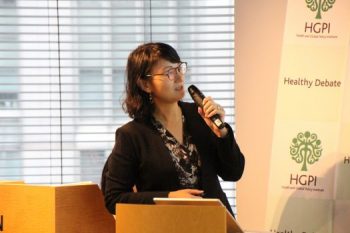[Event Report] The 73rd Breakfast Meeting – Ideas for Passive Smoking Prevention from the 2018 Public Survey on Healthcare in Japan (October 23, 2018)
date : 12/21/2018
![[Event Report] The 73rd Breakfast Meeting – Ideas for Passive Smoking Prevention from the 2018 Public Survey on Healthcare in Japan (October 23, 2018)](https://hgpi.org/en/wp-content/uploads/sites/2/IMG_0823-e1545389010204.jpg)
In June 2018, HGPI conducted the 2018 Public Survey on Healthcare in Japan (hereafter, the Survey). It asked 1,000 men and women over age twenty throughout Japan about secondhand smoke, the human papillomavirus (HPV) vaccine, and end-of-life healthcare.
Over 60% of Survey respondents said they have experienced secondhand smoke¹ either on the street or inside of an eating or drinking establishment. Approximately 60% of all respondents said they avoid entering establishments that allow smoking (excluding those with separate smoking sections) and approximately 40% of all respondents said they avoid entering establishments with separate smoking sections².
Given the actual conditions surrounding the issue and the revision of the Health Promotion Act passed in July 2018, Professor Yuri Ito and Mr. Kazuo Shimada were invited to the meeting to discuss their current efforts against passive smoking. Professor Ito is founder of an internet site called “Quemlin” that helps users find non-smoking eating and drinking establishments (her affiliations are detailed below). Mr. Shimada, who belongs to the Yoronotaki Co. Ltd. Restaurant Management and Development Group, explained his company’s current efforts in the movement towards creating non-smoking eating and drinking establishments.
※1 Passive smoking refers to non-smokers inhaling tobacco smoke from people smoking nearby.
※2 Taking into account the fact that many companies create partitions labeled “Non-smoking spaces” and “Smoking spaces,” the 2018 opinion survey labeled establishments with the terms “Smoking,” “Separate smoking sections,” and “Non-smoking.”
HGPI Board Member Kohei Onozaki began the meeting with an introduction of anti-passive smoking measures currently being pursued in Japan. Touching upon the fact that efforts to curb indoor passive smoking have been lax, he pointed out that approximately 80% of Japan’s population is non-smoking and explained that calls for a complete indoor smoking ban in eating and drinking establishments have increased in recent years.
■ Case study 1 (Ms. Yuri Ito)
On the current state of the movement to create non-smoking eating and drinking establishments and its effects
According to data gathered from Tabelog in August 2016, the area with the highest ratio of eating and drinking establishments that prohibit indoor smoking in Japan is Kanagawa Prefecture. Kanagawa Prefecture is one step ahead of the rest of the country as it is the first prefecture to implement a smoking ban for certain eating and drinking establishments, giving it a high ratio of such establishments compared to other areas in Japan. Although owners of establishments affected by the ban had been primarily concerned with the possibility of it hurting their bottom line, studies from various countries showed that bans had no such effects. In addition to this, approximately half of the establishments in the Michelin Guide are completely non-smoking. Taken together with the fact that Japan is the only country on the Club MICHELIN website that has an option to search for non-smoking establishments, this suggests that Japan is a step behind other countries in banning smoking in eating and drinking establishments.
The desire to support non-smoking eating and drinking establishments behind of the founding of Quemlin and its special reviewer dispatch system
Although Professor Ito was originally a smoker herself, since she is a researcher in the field of cancer epidemiology, she created the site out of a desire to introduce non-smoking establishments to all those around her and to support establishments that have banned indoor smoking.
There are currently 459 establishments listed on Quemlin. In the past, she personally visited non-smoking establishments to research them and create listings. However, to overcome the shortcomings of this method and to spread the word about which establishments have total indoor smoking bans to as many people as possible, she started a special volunteer reviewer dispatch system on World No Tobacco Day, which was May 31st, 2018. After gathering a number of volunteers from among those who share the vision of Quemlin, she had them visit eating and drinking establishments to see if they meet Quemlin’s standards. Owing to the fact that Professor Ito resides in Osaka, the area is over-represented in Quemlin’s listings (at 139 establishments, Osaka is the area with the most listings). In the future, she aims to increase the number of establishments on the site and will actively recruit special volunteer reviewers.
Comments from owners of eating and drinking establishments that ban indoor smoking and are listed on Quemlin
When interviewed, owners of establishments listed on the site had the following to say:
―Why did you ban smoking?
・Because the owner or their family had a change of health
・Because customers complained or there was other trouble with customers
・Out of consideration for current attitudes in society
・Because many of our customers were non-smokers
―What happened after you banned smoking?
・Although sales fell temporarily, they soon recovered to or exceeded their original levels.
・It led to an increase in income per customer. For example, some began to order expensive wine.
・Only a few of our regulars left us and we started getting more families.
・We were able to attract more part-time workers using our clean working environment as a draw.
・After our smoking ban, we learned that some of our regulars come from far away not to enjoy our food, but to smoke.
Future developments
Mrs. Ito would like for her efforts with Quemlin to be used to conduct research, for example to examine the relationship between the ratio of non-smoking eating and drinking establishments and health outcomes, or to conduct an intervention study using Quemlin. She, together with her team of special dispatch reviewers, would like to decrease the amount of passive smoking experienced at eating and drinking establishments near universities and hospitals in the future.


■Case study 2 (Mr. Kazuo Shimada)
The background of Yoronotaki Co. Ltd.’s trial indoor smoking ban
From May of this year, Yoronotaki Co. Ltd. conducted a trial indoor smoking ban in four of our (as of December 2017) 488 locations – the Yoronotaki Kabuki-cho branch and the Danmaya Suisan branches at Hirose-dori Station in Sendai, Porte Kanazawa in Kanazawa, and Sakae Sanchome in Nagoya. Since eighty percent of our restaurants are franchises and only twenty percent of them are directly operated by the parent company, we must be sensitive to changes in society and public opinion. Since people of middle and advanced age constitute a large portion of our customer base while families are only a small portion, we conducted a trial total indoor smoking ban to test its effects on our smoking customer base.
The effects of the indoor smoking ban on sales and new measures and experiments to gain customers
Average daily sales at our Kabuki-cho branch decreased considerably compared to May of last year, 2017. Sales also decreased at the branches in Sendai, Kanazawa, and Nagoya. Since we have restaurants other than these four locations, the drop in sales did not greatly affect our chain. However, if a privately-owned restaurant saw the same effects to its bottom line, it might be driven out of business.
To lessen the decrease in sales, we tried appealing to the public by advertising that we are fully non-smoking on social networks and on our homepage. Additionally, at the Danmaya Suisan Sakae Sanchome branch, we are actively testing new promotions, such as one in which customers can buy their first drink for 22 yen on the 22nd of every month, or by having a special service day for customers undergoing outpatient treatment for smoking. The first step is notifying many people of the merits of visiting our establishment which has completely banned indoor smoking.
Future Developments
In the future, we will continue our efforts to communicate the appeal of eating and drinking establishments that ban indoor smoking and to create spaces that are comfortable for non-smokers.
■Profiles
About Ms. Yuri Ito (Chief, Associate Professor Department of Medical Statistics, Research & Development Center Osaka Medical College/Research Area: Cancer Epidemiology, Health Inequalities, Health Statistics)
Yuri Ito is the Associate Professor at Osaka Medical College in Japan. She received her MSc and PhD in Health Science from Osaka University. Her research is based on the descriptive epidemiology in cancer using the cancer registry and other official statistics data for policy making and evaluation, since when she worked in the Osaka International Cancer Institute. She has started a website called “Quemlin”, which enables users to search for smoke-free restaurants, cafes, and bars by type of cuisine and location since October of 2015.
About Mr. Kazuo Shimada (YORONOTAKI CO., LTD., Restaurant Management & Development Group, Sales Strategy Section, PR Team)
Born in Tokyo in 1961. Graduated from the College of Sociology of Rikkyo University in 1984, and joined YORONOTAKI CO., LTD. that same year. After many years in the company’s restaurant development and franchise divisions, he was appointed Editor-in-Chief of the YORONOTAKI Group’s public relations magazine and PR Head in April 2018.
Top Research & Recommendations Posts
- [Research Report] The 2025 Public Opinion Survey on Healthcare in Japan (March 17, 2025)
- [Research Report] The 2023 Public Opinion Survey on Satisfaction in Healthcare in Japan and Healthcare Applications of Generative AI (January 11, 2024)
- [Policy Recommendations] Cancer Control Project “Policy Recommendations on Addressing Regional Disparities in Breast Cancer Care” (January 31, 2025)
- [Policy Recommendations] Developing a National Health and Climate Strategy for Japan (June 26, 2024)
- [Policy Recommendations] Dementia Project Information Packet for Local Government Officials “Dementia Policies for Our City: Taking the First Step in Promoting Future Measures for Dementia” (March 17, 2025)
- [Research Report] Building a Mental Health Program for Children and Measuring its Effectiveness (June 16, 2022)
- [Policy Recommendations] Achieving a Sustainable Society of Health and Longevity Through the Integration of Environment and Healthcare-Incorporating a Planetary Health Perspective into the 3rd Phase of The Healthcare Policy-(December 20, 2024)
- [Public Comment Submission] “GX2040 Vision (Draft)” (January 26, 2025)
- [Public Comment Submission] “Third Phase of The Healthcare Policy (Draft)” (February 3, 2025)
- [Policy Recommendations] Obesity Control Promotion Project 2023 “The Next Steps for Engaging and Cooperating with Patients, Citizens, and Communities for Implements of Obesity Control Measurements” (April 8, 2024)
Featured Posts
-
2025-03-24
[HGPI Policy Column] (No.57) From the Dementia Project “The Future of Dementia Research Co-created with Lived Experience, Vol.2: Person-Centered Care Approach and Patient and Public Involvement: A Best Practice Example from Sweden”
![[HGPI Policy Column] (No.57) From the Dementia Project “The Future of Dementia Research Co-created with Lived Experience, Vol.2: Person-Centered Care Approach and Patient and Public Involvement: A Best Practice Example from Sweden”](https://hgpi.org/en/wp-content/uploads/sites/2/HGPI_202503_Person-centered-care-approach-and-Patient-and-Public-Involvement_-A-Best-Practice-Example-from-Sweden.jpg)
-
2025-03-26
[Registration Open] (Webinar) The 132nd HGPI Seminar “Considering the Ideal Evidence-Based Immunization and Vaccination Policies” (April 25, 2025)
![[Registration Open] (Webinar) The 132nd HGPI Seminar “Considering the Ideal Evidence-Based Immunization and Vaccination Policies” (April 25, 2025)](https://hgpi.org/en/wp-content/uploads/sites/2/hs132-top.png)
-
2025-03-28
[Policy Recommendations] Cancer Control Project “Policy Recommendations on Addressing Regional Disparities in Breast Cancer Care” (January 31, 2025)
![[Policy Recommendations] Cancer Control Project “Policy Recommendations on Addressing Regional Disparities in Breast Cancer Care” (January 31, 2025)](https://hgpi.org/en/wp-content/uploads/sites/2/Policy-Recommendations-on-Addressing-Regional-Disparities-in-Breast-Cancer-Care-top.jpg)
-
2025-03-31
[Event Report] The 125th HGPI Seminar “Progress and Prospects for Domestic Measures on Health Problems Caused by Alcohol” (May 24, 2024)
![[Event Report] The 125th HGPI Seminar “Progress and Prospects for Domestic Measures on Health Problems Caused by Alcohol” (May 24, 2024)](https://hgpi.org/en/wp-content/uploads/sites/2/HGPI_20240524_125thHGPIseminar_Eyecatch_rev-1.jpg)
-
2025-04-02
[Registration Open] Public Event “The Patient and Citizen Lived Experience Forum 2025” (May 17, 2025)
![[Registration Open] Public Event “The Patient and Citizen Lived Experience Forum 2025” (May 17, 2025)](https://hgpi.org/en/wp-content/uploads/sites/2/HGPI_20250517_PeoplewithLivedExperienceForum2025-.jpg)




